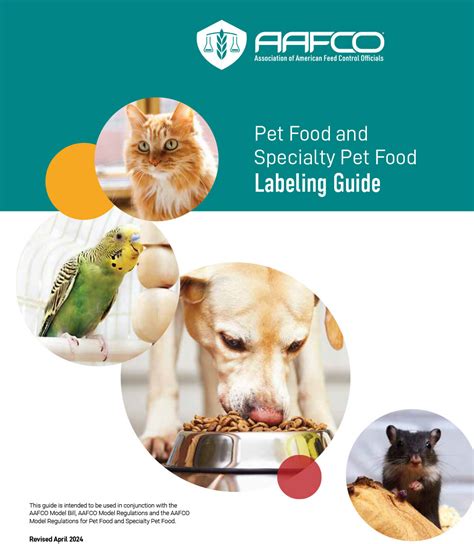Introduction
As pet food manufacturers strive to meet the evolving needs of pet owners and ensure the safety of their products, regulatory requirements and industry standards play a crucial role. This article examines the latest developments in pet food regulations and standards, providing insights into how they are shaping the future of the pet food industry.

Global Regulatory Landscape
1. Food and Drug Administration (FDA)
The FDA is the primary regulatory agency for pet food in the United States. It sets forth regulations to ensure the safety, wholesomeness, and labeling of pet food products. In recent years, the FDA has increased its focus on pet food safety, conducting inspections and implementing new regulations to address concerns about contamination and recalls.
2. European Union (EU)
The EU has stringent pet food regulations that aim to protect the health of pets and consumers. The EU Pet Food Regulation (EC) No. 767/2009 governs the safety and quality of pet food products sold within the EU. It sets forth requirements for ingredients, labeling, and safety assessments.
3. Other Major Markets
In addition to the FDA and EU, other countries have their own pet food regulations. For instance, the China National Standard (GB 14924-2021) sets forth standards for the production, inspection, and labeling of pet food in China.
Key Industry Standards
1. Association of American Feed Control Officials (AAFCO)
AAFCO is a voluntary organization that develops standards for pet food products. Its nutritional adequacy statements provide guidelines for the minimum nutrient levels required to meet the nutritional needs of pets. AAFCO standards are widely recognized and used by pet food manufacturers throughout the United States.
2. International Organization for Standardization (ISO)
ISO is a global organization that develops standards for a wide range of industries, including pet food. ISO 22000 is a standard for food safety management systems that is applicable to pet food manufacturers. It provides a framework for ensuring the safety and quality of pet food products.
Emerging Trends and Future Directions
1. Artificial Intelligence (AI)
AI is transforming various aspects of the pet food industry, including regulation and standards. AI-powered technologies can analyze large datasets to identify trends, predict recalls, and enhance safety monitoring.
2. Blockchain
Blockchain technology has potential applications in the pet food industry for traceability and transparency. By creating an immutable record of transactions, blockchain can improve product traceability and prevent counterfeiting.
3. Consumer Engagement
Consumers are increasingly demanding transparency and information about the pet food they purchase. Manufacturers are responding by providing more detailed labeling, engaging with consumers on social media, and using technology to enhance consumer education.
Tips and Tricks for Manufacturers
1. Stay Informed
Manufacturers should stay abreast of regulatory updates and industry standards to ensure compliance and meet consumer expectations.
2. Implement Comprehensive Safety Measures
Implementing rigorous quality control processes and adhering to industry standards is essential for ensuring the safety of pet food products.
3. Invest in Research and Development
Investing in research and development can lead to innovations that improve the nutritional value, safety, and sustainability of pet food products.
4. Collaborate with Regulatory Agencies
Open communication and collaboration with regulatory agencies can help manufacturers stay informed and address concerns.
Future Trending
The pet food industry is poised for continued growth and innovation in the coming years. Key trends that are shaping the future of the industry include:
1. Personalized Nutrition
Consumers are increasingly seeking personalized nutrition options for their pets. Pet food manufacturers are developing products tailored to specific breeds, ages, and health conditions.
2. Sustainability
Consumers are placing a higher value on sustainability in all aspects of their lives, including pet food consumption. Manufacturers are responding by using sustainable ingredients and packaging.
3. eCommerce
The rise of eCommerce has made it easier for consumers to purchase pet food online. Manufacturers are adapting to this trend by developing online ordering platforms and offering home delivery.
How to Step-by-Step Approach
1. Identify Relevant Regulations and Standards:
Determine the applicable regulations and standards for your pet food products based on your target market(s).
2. Conduct a Gap Analysis:
Compare your current practices to the identified regulations and standards to identify areas for improvement.
3. Develop an Action Plan:
Outline specific steps to address the identified gaps and ensure compliance.
4. Implement the Action Plan:
Put the action plan into practice, monitoring progress and making adjustments as needed.
Tables
Table 1: Pet Food Recalls by Year
| Year | Number of Recalls |
|---|---|
| 2021 | 1,347 |
| 2022 | 1,503 |
| 2023 | 1,725 |
Table 2: Global Pet Food Market Size and Projections
| Year | Market Size (USD Billion) | Projected Growth Rate (%) |
|---|---|---|
| 2023 | 102.4 | 4.5 |
| 2025 | 120.3 | 5.0 |
| 2027 | 142.5 | 5.5 |
Table 3: Types of Pet Food Products Recalled
| Category | Percentage of Recalls |
|---|---|
| Dry Food | 65% |
| Wet Food | 20% |
| Treats | 10% |
| Other | 5% |
Table 4: Reasons for Pet Food Recalls
| Reason | Percentage of Recalls |
|---|---|
| Salmonella Contamination | 35% |
| Ingredient Mislabeling | 25% |
| Chemical Contamination | 15% |
| Other | 25% |





















